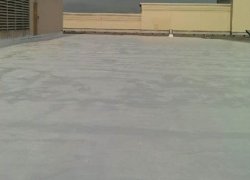COMMERCIAL FLAT ROOF INSTALLATION, TYPES AND REPAIR
Commercial roofing is a bit different from residential roofing system since these are generally bigger projects with different architectural patterns and built depending on the purpose of the building. A building meant for a multiplex and a building meant for a supermarket can’t have the same roofing system. Moreover, in a commercial roofing long sustenance and low maintenance are two major aspects.
Types Of Commercial Roofing
In a new building or where a roof requires replacement, a commercial roofing types can be categorized into the following fundamental heads:
Thermoplastic Roofing
This belongs to the single-ply roofing system. These products are highly flexible and capable of withstanding in high temperature. The most common thermoplastic roofing is polyvinyl chloride (PVC) and thermoplastic olefin (TPO). The other sub-categories are tripolymer alloy (TPA), copolymer alloy (CPA), ethylene interpolymer(EIP), etc. These roofs sustain at least 15-20 years even in adverse weather conditions and at very low maintenance.
EPDM (Ethylene Propylene Diene Terpolymer) Roofing
EPDM (Ethylene Propylene Diene Terpolymer) is a highly flexible, sustainable, robust single-ply roofing system. This material is too popular as a low-slope commercial roofing material. Ethylene and propylene are the two principal compounds in this material. EPDM can be installed in three ways: fully adhered, blasted, and mechanically attached. The product is available in 7.5 feet to 50 feet widths and in 45 and 60 mils thickness. Commercial roofing companies prefer EPDM because these products are easy to install, last long, and easily replaceable. Read here more on flat roof types and replacement options.
Green Roofs
These roofs, also called eco-roofs or vegetation-roofs, are getting popularity as a part of thego-green revolution. These roofs are generally partly or fully covered with green vegetation with a waterproofing layer beneath the vegetation. It also includes 2-3 additional barriers as root barriers and drainage system. Green roofs have many benefits for a building. It can keep the inside temperature very comfortable in summer and preserve the warmth of inside environment of the building in winter.
Flat Roof For Commercial Buildings
In most of the commercial or industrial buildings flat roofing system could be visible. Flat roofing has several advantages for the building:
- It requires minimum maintenance and these roofs are easier to inspect
- The cost of installing flat roofs or its repair service is lower than the other types of roofs
- It provides more stability to the whole building and offers more horizontal structure
- The roof can be utilized in some other reasons related to the building or owner
Commercial Flat Roof Repair
Normally, a well-designed commercial flat roof remains intact at least 15-20 years with a little maintenance. However, during adverse weather conditions, these roofs may get damaged and require repairing service. In such conditions, it is feasible to contact an experienced and popular commercial roofing company for a suitable repairing job. A professional contractor takes into account all common issues like leakage and sipping of water, puddles of water due to damage on the roof or poor drainage system, and energy inefficiency of the roof.

